Peter MALONE
Saturday, 18 September 2021 19:43
Shot in the Dark, A
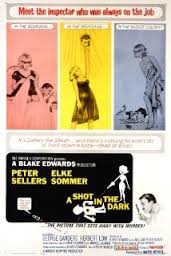
A SHOT IN THE DARK
US, 1964, 102 minutes, Colour.
Peter Sellers, Elke Sommer, George Sanders, Herbert Lom, Tracy Reid, Graham Stark, Moira Redmond, David Lodge, Andre Moranne, Martin Benson, Burt Kwouk, Reginald Beckwith.
Directed by Blake Edwards.
Peter Sellers made such an impression in the 1963 Pink Panther as the bumbling Inspector Clouseau, that Blake Edwards decided that he should be the star of a sequel. Adapting a murder mystery play, the screenplay was designed to focus on Inspector Clouseau, his verbal mix-ups, his pratfalls. In this, it was completely successful. Peter Sellers is very funny and the whole film is a rollicking example of Pink Panther humour. Elke Sommer is the romantic lead and the suspect in the murders. George Sanders offers his sinister presence. Herbert Lom resumes his role as Inspector Dreyfus and was to continue this, along with Burt Kwouk as Clouseau’s martial arts adviser, in the numerous sequels including The Return of the Pink Panther, The Revenge of the Pink Panther.
Blake Edwards had begun directing smaller-budget films in the 1950s but moved into stronger and bigger-budget films with Days of Wine and Roses and Experiment in Terror. At this time he also made The Great Race. He also married Julie Andrews and featured her in such films as Darling Lili and The Tamarind Seed.
This is probably the funniest of the Inspector Clouseau films – and it also introduced the variation on the Pink Panther theme by Henry Mancini, the Inspector Clouseau theme.
1. The significance and tone of the title? How entertaining a comedy? Peter Sellers comedy? Spoof of detective vehicles?
2. How well did the film stand on its own as a Peter Sellers comedy, the character of Inspector Clouseau? As a sequel to The Pink Panther? The sequels conceived ten years later in the seventies? The particular characteristics of murder mysteries, the bumbling detective? How much better than the usual conventional comedy via comedy and parody?
3. Panavision photography, French locations? The importance of the various sets especially the home and the opening, the Surete? The various amusing locations, for example the nudist colony? The A11? Importance of the music? 'the Rues of Paris', 'The Inspector' theme? The effects of the credits sequence and the humorous animation?
4. How credible was the plot? The confusion with all the people moving around the house at the beginning and then the shot in the dark? The society situation with the murder? and so many guilty? The various murders? The Surete and the investigations? Inspector Clouseau walking heavy footedly through all the investigations? Enough plot for comedy purposes?
5. The particular characteristics of Peter Sellers' impersonation of Inspector Clouseau? His personality, indifference to the truth, for example, his sharing of the facts with Werrule? His mistakes, his accidents and bumbling, his mispronunciations? His letting Maria go from the prison
so many times? His being arrested? The effect on Dreyfus? How clever a characterisation? The traditions of visual comedy, the verbal comedy, slapstick and sight gags?
6. The supporting characters seen within the shadow of Clouseau? Mary, the conventional maid, and Elke Sommer's attractiveness? George Sanders as the suave millionaire? for example the sequence in the billiard room? Dreyfus and his gradually going mad, for example guillotining his thumb,
his twitch, his trying to assassinate Clouseau and killing so many people? llercule and his helping of Clouseau?
7. The effect of the introduction with the Henry Mancono song and the confusion of characters and the transition to the animation and the introduction of the character of the Inspector? How well did this set a tone for the film?
8. Comment on the various set comedy pieces, for example Clouseau's speeches, his falling in the water and tearing his clothes etc.? His painting, his being arrested so many times, the nudist colony sequence? His final summing up of the case?
9. Why do audiences enjoy such films? The humorous treatment ef crime, justice, good ard evil?
Published in Movie Reviews
Published in
Movie Reviews
Tagged under
Saturday, 18 September 2021 19:43
Shrine of Lorna Love, The/ Death at Love House
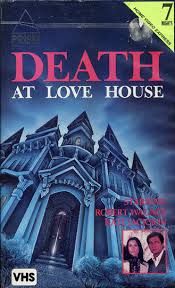
THE SHRINE OF LORNA LOVE (DEATH AT LOVE HOUSE)
US, 1976, 74 minutes, Colour.
Robert Wagner, Kate Jackson, Sylvia Sidney, Marianna Hill, Dorothy Lamour, Joan Blondell, John Carradine.
Directed by E.W. Swackhamer.
A telemovie taking advantage of the 70s interest in Hollywood and the thirties and the giamour of past stars. It also has dashes of the occult. However, the film's running time is brief and there is a rather sketchy presentation of these themes. The film is of interest in its re-creation of the shrine for the thirties' sex symbol. It is also interesting in its overtones of the occult and features interesting cameos from Dorothy Lamour, Joan Blondell and John Carradine. Robert Wagner and Kate Jackson are an attractive lead couple. Interesting - but it might have been much better.
1. Audience interest in Hollywood in the thirties, the stories, the glamour, the, myths? The seventies' interest in the occult? How well did this film combine these themes?
2. The brief running time of the telemovic - suggesting of themes, creation of atmosphere, the mystery, sustaining audience interest, the resolution? with the commercial breaks and the home viewing? How difficult to sustain suspense and atmosphere for television viewing?
3. The contribution of the set especially Lorna Love's house, her gardens, the shrine? Decor? affluence, bizarre? The importance of the flashbacks and the immersing the audience in Joel Gregory's memories, imagination, Lorna Love's world? The irony of the opening and close with the tourist bus and the painting going to the museum? Audience identification with the tourists going into this unusual world? and glad to escape at the end?
4. Joel and Donna as an ordinary contemporary couple, their arriving on the tourist bus. their fascination with the house, their job? Joel's interest in getting to understand his father? Oscar and his explanations and commercial interests, Mrs Joseph and her administration of the house and ambiguous attitudes? Hostility towards Donna, attraction towards Joel? The continual focus on the portrait of Lorna and its seeming to have a soul compared with the reality? The puzzle about her personality? The house and the rooms an revealing her character? The threat of the house and the ominous tones of to shrine? Marissa and her running through the garden? The background of father/eternal-fire and witchcraft emblems?
5. The ordinariness of the couple? Donna and her pregnancy, reaction to the storms, to Carol's visit and his death? Donna and the cutting of the photo, the threat in the shower, the clash at Marissa's house, the arguments with Joel and her leaving? Oscar's advice to go and drag him away? Her intrepid behaviour in doing this?
6. Joel and his continued fascination with the picture, the interview with Denise, with Carol, with Marissa? The hallucinations and memories of his dancing with Lorna, the key of her bedroom being left, his imagination of Mexico and the outing, his lying on her bed, her final appearing? His fascination with the shrine? The rescue of Donna and then the clashes? The taking over of his personality by his father's memory?
7. Carol and his visit and his quick indicating of his hostility towards Lorna and revealing something of her character, the ugliness of his death? Denies and her commercial and the story of rivalry, her knowing Joells father, Lorna's destructiveness? Marissa and the fan club and the ambiguity of attitudes especially towards the witchcraft emblems?
8. Lorna herself, the portrait, her being embalmed, her films? Her presence in the flashbacks, her speaking from the screen? Her hold over Joel, the dancing, the flashback in Mexico and her capriciousness? Her possessing Joel and her appearing on the bed? and the ugliness of the truth about her burning? The talk about her, her reputation and Hollywood behaviour? A sinister personality?
9. The character of Mrs Josephs, housekeeper, kind towards Joel, antagonistic towards Donna, rescuing her? The finale and the truth?
10. Joel's allowing himself to be taken over, his fighting it, the burning of Lorna? The witchcraft and its being a red herring for the audience? The failure of the witchcraft?
11. The symbolic ending with Lorna burning and not gaining eternity, the van and leaving with her picture?
12. Films like this satisfying audience curiosity? The values that such films presuppose about good and evil, right and wrong, celebrities?
Published in Movie Reviews
Published in
Movie Reviews
Tagged under
Saturday, 18 September 2021 19:43
Shuttered Room, The

THE SHUTTERED ROOM
UK, 1967, 99 minutes, Colour.
Gig Young, Carol Lynley, Oliver Reed, Flora Robson.
Directed by David Greene.
The Shuttered Room has a strong reputation as a satisfying atmospheric horror thriller. The film has eerie locations, a dilapidated house, a sense of menace. Carol Lynley is stalked, Oliver Reed is the stalker. There is a strong jazz score, Gothic atmosphere which also combine to substantial effect.
The film was directed by David Greene who directed a lot of British television, made some films in England including Sebastian and The Strange Affair before moving to Hollywood with Godspell and having a prolific career making telemovies.
1. The tone of the title, the mood of the prologue, the saccess of the film an a horror-scary film? How conventionol was it? Did it use the conventions well?
2. Comment on the use of British scenery - an American landscape. Did the British atmosphero give this American story some strength or did it detract from it?
3. How convincing were the charactors? were they well prepared for the ordeal or were ther merely there to go through the horror pieces? Susanna and audience identification with horror? The importance of her conquering her fear? Her rightful ownership? Her relationship with her husband? The fact that she was terrifled throughout, mood of the film? audiences sharing her terror? How? Was her husband a well-developed, character, or was his role merely to support her in the film?
4. How ominous was the island itself? the landscapes, the houses, people, hositility, the tower itself? The initial meeting with Ethan, his gang?The track chase, the wire, the evil and hositility?
5. The tower itself? The suggestions of presence and a fear? Aunt Agatha and her relationship with the tower? Was Aunt Agatha’s character explored or was she merely a figure of terror and of puzzle?
6. The girl who firghtened Susanna and her role in the film? The reality of the wind, the mill, house, tower? Should Aunt Agatha have kept the home alive?
7. The eerieness in the house, how well filmed was this? How do films like this create an atmosphere of fright? Why are audiences firghtened?
8. How well portrayed was the character of Ethan? Oliver Reed's style? As the equivalent of a bikie leading a gang? His callousness? His brutality towards Mike? His harrassing Susanna? The inevitability of his death?
9. The harassing of Sawanna on the pier? How important?
10. The Importance of night in the film? The use of night and darkness for horror effects?
11. The fire? was it too contrived? The role of Ethan, Susanna, in the shattered room, the role of Agatha? The importance of Aunt Agatha locking herself in the room with the sister? did she choose to die with her?
12. How satisfactory was the resolution of the whole film? successful minor horror film?
Published in Movie Reviews
Published in
Movie Reviews
Tagged under
Saturday, 18 September 2021 19:43
Skateboard

SKATEBOARD
US, 1978, 98 minutes, Colour.
Allen Garfield, Kathleen Lloyd, Leif Garrett.
Directed by George Gage.
Skateboard is as it sounds. A man in debt, played by Allen Garfield, is set upon by some young people, skateboarders. When asked to pay up, he gets a brainwave that he will promote skateboarding.
The film is a blend of this small fiction along with a whole demonstration of the skills of skateboarding in the 1970s. For skateboard fans only.
1. An enjoyable film? Reflecting a trend of the seventies, a fad? For what audience was the film made?
2. Production values, colour photography, California settings, the skateboard sequences?
3. The work of the stars, their styles and improvisation? focus on Leif Garrett, for younger audiences?
4. Audience response to the skill in skateboard riding? The various examples, the photography, the tests, the mishaps, the successes?
5. The focus on Manny as the main character, California type, promoter, conman, in debt? Starting his car, employment office, alimony? A wheelerdealer? His link with Sol and money?lenders and their toughs? His need for money, the car etc.? Reaction to the skateboard kids in the street?
6. His brainwave about promoting skateboard riding, his push with the promoters, with the boys and girls? Hiring buses? His running and compering of the shows etc.?
7. The portrayal of the boys and girls, their skateboard skills, their families? Their characters in themselves, sexuality and Jason and his girlfriend, the boys' talk? Their reacting to one another, to Manny? To the pressures of training and the shows? Their enjoyment of success?
8. Millicent as a character, conning Manny into the job, her performance and relationship with the kids, especially Jason and his brother? Her support of Manny?
9. The training sequences, Manny's pressure because of the pressure on him? His being bashed in the motel? The pressure on Jason and his running away?
10. Brad taking Jason's place, training and success? The final race and the money issue?
11. How did the film reflect the styles of the seventies? The themes of adolescence, sport and achievement, relationships and responsibility?
Published in Movie Reviews
Published in
Movie Reviews
Tagged under
Saturday, 18 September 2021 19:43
Ski Lift to Death
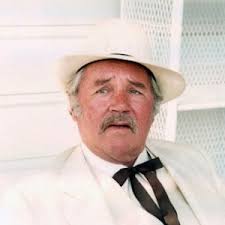
SKI LIFT TO DEATH
US, 1978, 100 minutes, Colour.
Howard Duff, Don Galloway, Charles Frank, Clu Gulager, Veronica Hamel, Don Johnson.
Directed by William Wiard.
Conventional telemovie material of the disaster type. The film spends a lot of time establishing its basic characters in the world of sport and competitiveness, shows quite a deal of champion ski jumping and design skiing and then moves to the disaster but with the proviso that people are not scared away from ski resorts and so there is a happy ending.
1. The appeal of such telemovie thrillers? Catering for the home audience for interest, excitement?
2. The basic entertainment presuppositions ? the establishing of ordinary characters, the threatened disaster, personal relationships? The fantasy world of the wealthy and their emotional troubles, danger - with the hired killer? The values presupposed of good and evil, right and wrong, solutions to problems?
3. Colour photography, locations, the chalet, the snow? The special effects especially with the skiing competitions?
4. How credible were the characters, the basic situations especially the emotional conflicts? The issues of money, competitiveness and career? Audience response to these issues?
5. How well did the film explore the theme of sport, skill, fame? Advertising especially for Lee, Mike? Mary and his elaborate explanation about advertising and personalities? The need for personal decisions? Proving oneself? Lee as the central character, her relationship with Mike, her work, skill? Her being saved by Mike?
6. The rivalry of champions? The winner of the competition, his carefree attitude towards life, the liaison with Wendy, her age, being away from home? His escaping from the ski lift with Wendy and helping Marv?
7. The extortion theme - the personalities, the Federal threats, the older man talking with his con, his mistress?and her being planted to get him killed, the plan about the windcheater, his wearing it, the accident and their sharing the fear? The murderer and his pursuit? (the irony of their all visiting the church on the Sunday?), the chase, the possibility of reconciliation, the woman and the assassin going to prison?
7. The reality of the accident, the snow locations, weather, safety, the skill in the rescue and its detail? An air of authenticity?
8. How well did the film blend the elaboration of character, melodramatic situations and clashes with competition, the skill of skiing, the movement of the dance competition, the accident and rescue? A satisfying telemovie entertainment?
Published in Movie Reviews
Published in
Movie Reviews
Tagged under
Saturday, 18 September 2021 19:43
Ski Raiders/ Snow Job
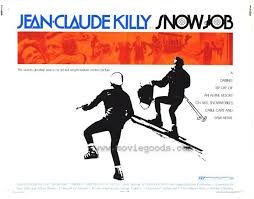
SKI RAIDERS (SNOW JOB)
US, 1972, 90 minutes, Colour.
Jean- Claude Killy, Daniele Gaubert, Cliff Potts, Vittorio de Sica, Delia Boccardo, Umberto D'Orsi.
Directed by George Englund.
This film is a star vehicle for skiing champion, Jean- Claude Killy. He is a thief, searching for money, pursued in mountainous territory – which gives the opportunity for a basic crime thriller plot as well as plenty of examples of skiing in beautiful locations. The film was directed by George Englund, better known as a producer (Shoes of the Fisherman, See How She Runs) who directed only eight feature films, the most prominent of which was his first film, The Ugly American, with Marlon Brando.
1. How enjoyable a thriller? Robbery background, doublecrossing plot? The ski background?
2. The appropriateness of the title? The original American title was 'The Snow Job'. Is this a better title?
3. The impact of the introduction, the colour and Panavision setting of the snow, the atmosphere of the ski resort?
4. The importance of having a skiing champion as the star? His personality and acting capacities? His skiing techniques and their utilization in the film?
5. Comment on the plot and the intricacies. The details of the planning, the personalities involved, the rehearsal and robbery itself? The detail and the twist?
6. How important were the characters for this film? Christian and his planning? His relationship with Monica? With Bob? His doublecrossing them? The importance of the character interaction during the robbery?
7. The character of Dolph? His work as an insurance investigator? His personality? His stealing the money? The revelation at the end?
8. Why do such robbery films appeal?
9. The value of the twist at the end?
10. How conventional a thriller?
Published in Movie Reviews
Published in
Movie Reviews
Tagged under
Saturday, 18 September 2021 19:43
Skidoo
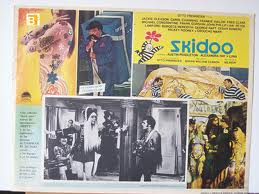
SKIDOO
US, 1968, 97 minutes, Colour.
Jackie Gleason, Carol Channing, Frankie Avalon, Fred Clark, Michael Constantine, Frank Gorshin, John Philip Law, Peter Lawford, Burgess Meredith, George Raft, Cesar Romero, Mickey Rooney, Groucho Marx, Arnold Stang, Doro Merande, Slim Pickens, Richard Kiel, Harry Nilssen, Austin Pendleton, Alexandra Hay, Donyale Luna.
Directed by Otto Preminger.
Skidoo is an odd film. It was even odd at the time that it was produced in the late 1960s. Otto Preminger had proven himself one of Hollywood’s top directors especially with Laura in 1944 when he went on to make a number of big-budget films including Forever Amber but also some small-budget films like The Moon is Blue, which raised controversy about its use of the word ‘virgin’ and ‘pregnant’, challenging the Motion Picture Code. By 1959 he was making bigger-budget films including Anatomy of a Murder, Exodus, Advise and Consent, The Cardinal, In Harm’s Way. With the upheaval of the 1960s, Preminger thought that he would make an offbeat hippie, acid comedy.
Groucho Marx, in his last film, portrays God, the head of the Mob. He employs Jackie Gleason who is in retirement with his wife Carol Channing. There are complications in the carrying out of the hit, Jackie Gleason going to prison, meeting with all kinds of oddball characters.
The film has several of the old faces of Hollywood feigning acid trips in the 60s style. And Harry Nilssen sings all the final credits.
The film was not released in some locations because of its presentation of drugs and drug culture. It now stands as a strange addition to Otto Preminger’s work and an odd film of the 60s.
1. A typical comedy of the 1960s, the psychedelic era of the late sixties, drugs? The film judged a failure on release? Not released in Australia, possibly because of the drug sequences? Was the film a successful comedy? Its impact in the seventies?
2. What kind of comedy? Jackie Gleason and his style, Otto Preminger and, his heavy style? The cue taken from the satire on television at the opening?
3. The quality of the comedy as a farce? About the American way of life? The film as a message comedy about the American way of life?
4. The picture of American society in the late sixties? A satirical look? Criticism of the establishment and its respectability, yet on the basis of crookedness and gangsterism? The hippies and their odd look and yet their kindness? The importance of the confrontation with the Mayor at her expelling the hippies from the city?
5. The atmosphere in America of the evil of drugs versus the evil of gangsterism? The exaltation of drugs? Was this justified?
6. The film's focus on Tony? Jackie Gleason's style, his friendship with Harry and his death, his career based on being a gangster, his relationship with "God"? His relationship with Flo and his daughter Darlene? His double standards, loyalty to God and attacking of the hippies? His willingness to go to prison and murder Packard? The criticism in this surface respectability?
7. The satire on the American wife and mother in Carol Channing's performance? Flo in exuberant but empty, sympathetic to the hippies, loving her husband and daughter, willing to compromise herself with a criminal, leading the rescue, etc.? The significance of her singing the song at the end?
8. The portrayal of the hippies in the atmosphere of the late sixties? The cliches about hippies opting out, freedom, their jargon, drugs and friendship? Stash and his relationship with Darlene? Yet his help of Tony and the hippies rescuing the establishment? The humour of this with the small boats and the siege of the yacht?
9. The picture of gangsters and criminals in America; Hechy and his son, careers from God, Angie and his elaborate apartment and the satire on mechanism and comfort? The seductions? Packard and his running things from prison? The prison contacts? The head criminal in isolation and in fear of germs calling himself God? And his assistant? The comment on American criminals, farcical comment?
10. The portrayal of Chris and life, the emphasis on the professor, his persecution and haircut, etc.? The picturing of the guards?
11. Audience response to the taking of L.S.D.. the L.S.D. fantasies? As experienced by Tony in terms of colour, reduction in size, etc.? The preparation for the use of L.S.D. for the escape?
12. How effectively comic was the escape sequence? Impossible things happening because of the L.S.D? The visit of the Senator and the prison Governor? The satire in these two men? (The Senator being reprised from the initial television satire?) The guards and their hallucinations, the garbage tin dance, the phone exchange men and their hallucinations? Packard and God intervening within this framework?
13. The picturing of God and his role on the yacht, the fact that George Raft was his assistant? His values and way of life? The appropriateness of Groucho Marx in this role? His use of Stash, imprisoning of Darlens, the rescue?
14. The final comment on America and what was wrong in the sixties? The comment on gangsters throughout the film tying in with the television interviews at the beginning?
15. The importance of the credits being sung and their effect?
16. To what purpose was this film really made?
Published in Movie Reviews
Published in
Movie Reviews
Tagged under
Saturday, 18 September 2021 19:43
Sea Wife
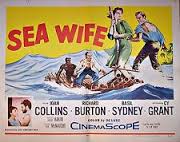
SEA WIFE
UK, 1957, 81 minutes, Colour.
Joan Collins, Richard Burton, Basil Sydney, Cy Grant, Ronald Squire, Joan Hickson, Norah Nicholson, Ronald Adam.
Directed by Bob Mc Naught.
If there were to be a competition to name the most unlikely actress to portray a nun on screen, Joan Collins would be somewhere in the top ten. However, in Sea Wife, she is a nun.
The film has a World War Two setting. A cargo ship with evacuees from Singapore is sunk by a Japanese submarine. There are four survivors in a lifeboat. The black seaman knows that the woman is a nun. However, the bigoted administrator (Basil Sydney) and the officer (Richard Burton) do not.
While the film is one of survival as well as the integrity of the nun, the main action, while the group drifts, is flashback of reminiscences about their life.
Richard Burton had emerged as a hero for American films after his stage and screen career in England. He had appeared in such spectaculars as The Robe and Alexander the Great. He was to make a number of films in Britain including Look Back in Anger. However, with the making of Cleopatra and the meeting with Elizabeth Taylor, his whole career changed – sometimes for the better, many times for the worse. In the meantime, Joan Collins had also moved from England and appeared in a number of big-budget American films including The Girl in the Red Velvet Swing, Land of the Pharaohs, The Opposite Sex. She was to continue a headlining career for many decades, especially with her starring role on American television in Dynasty. The film has some links with the theme of Heaven Knows, Mr Allison, with Robert Mitchum and Deborah Kerr. It is interesting to compare Deborah Kerr and Joan Collins as nuns on screen.
I. How interesting and enjoyable a drama? The issues?
2. The contribution of Cinemascope, colour, the sea locations, music?
3. The structure with the introduction to Michael Cannon, the flashbacks, the ironies and the irony of the ending? The brevity of the film?
4. Initial audience interest in Michael Cannon? His puzzling behaviour and telegrams and advertisements on the ship? Curiosity concerning his return to Enrland? Richard Burton's style? Serious man, the collage of advertisements and the lack of progress? (The humour of Cannon's visit to the club and the clue about the racehorse?)
5. The introduction to Bulldog, his presence in the asylum, his image of himself justifying himself after the events? The significance of the flashback at this point?
6. The importance of the audience knowing all the informatation throughout the film when the characters didn't? What advantage did this give to the audience for understanding the characters, the issues, the strange behaviouor? The recreation of the evacuation of Singapore, the atmosphere of the war, the refugees and the ships? The purser and his doing his job, the nuns and looking after the children, Bulldog and his arrogance and wanting to get a cabin?
7. Was there sufficient introduction to the characters before the torpedo hit? How well was the atmosphere of panic, the ship sirking conveyed? The presentation of the Japanese and their skill in sinking the ship? The lifeboats, Bulldog and his pushing, Michael Cannon and his being wounded and jumping? Sister Therese and her surviving the lifeboat and the four finally finishing in the lifeboat, watching the ship go down, the prospect of coping?
8. How interesting were the sequences on the sea? How well did the four cope? The four and what they represented: man and woman, racial backgrounds, English and supremacy? Power and who commanded? Survival and life and death? The confrontation of the elements? the moods of the sea, the breeze and the winds? Then possibility of swimming, sharks? The contrast with the savage storms? Food and drink? Rain?
9. How interesting was Michael as a character in the lifeboat? As hero, ill, his wisdom? The significance of his nickname of 'Biscuit'? His giving his own name, the name of 'Sea Wife’ to the nun? The irony of his not understanding the Sister's identity? His falling in love with, her, the sig.nificance of his relationship and how she helped him? The obsession at his return to try to find her identity? The motivation and compulsion of his search?
10. The character of Sea Wife? The sigificance of the name and the mermaid ard her not being fully mortal?
Feminine but not fully sexually feminine? The significance for the nun? Seeing her on the ship, her work, her surviving, her decision not to tell the others? Was it wise? Number Four and his guarding her secret? His using this information with the Japanese for their survival? The bond between Sister and Number Four? sister and her explanation of her religion to Bulldog and his not understanding, his own arrogance and self-confidence? As a genuine nun, her vocation, her feelings for Biscuit and her control? Her role in uniting the survivors, her horror at Number Four’s death? Michael told that she had died, her passing him on the path and her comments about a nun's face? The raising of her eyes to heaven - Hollywood-style religion? How interesting a characterisation of a nun? How plausible?
11. Bulldog as the arrogant British? The pathos of his being in the asylum, his self-justification? His arrogance at Singapore, his racist attitudes and his language, his continually beinrg offensive? The bashing of the birds? His being saved by Number Four and the irony of his being responsible for Number Four's death? His two-faced behaviour on the island, his hiding the knife? His takinp the raft away? His being responsible for Four's death? Was he right in telling Michael that Sea Wife had died?
12. The characterisation of Number Four: racial background, his work, on the ship? his surviving? His helping and considerinp himself an equal passenger on the lifeboat? his helping the group cope? Saving Bulldog in the storm? The building of the raft, the importance of the knife and his havingpower? His fear and his creating of fear?
To what extent was he responsible for Bulldog’s action? The pathos of his swimming out and his death?
13. Themes of survival, human nature? The film as an allegory about existence and survival in the world? relationships? Good and evil? Religion?
Published in Movie Reviews
Published in
Movie Reviews
Tagged under
Saturday, 18 September 2021 19:43
Sea Shall Not Have Them, The
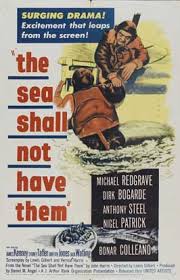
THE SEA SHALL NOT HAVE THEM
UK, 1955, 91 minutes, Black and white.
Michael Redgrave, Dirk Bogarde, Anthony Steel, Nigel Patrick, Bonar Colleano, James Kenney, Sydney Tafler, Griffith Jones, Guy Middleton, Ian Whittaker, Victor Maddern, Eddie Byrne.
Directed by Lewis Gilbert.
The Sea Shall Not Have Them is one of the many tributes to the heroism of Britain in World War Two. The film focuses on a bomber which crash-lands in the North Sea. The group has to survive, especially with an air-commodore with vital secrets. The film also shows the rescue team of the RAF and its attempts to get to the men. The film climaxes with a dramatic rescue. Meantime the group on the sea reminisce about their lives, trying to keep up morale, trying to survive in the cold weather.
Michael Redgrave is the air-commodore. A young Dirk Bogarde is the flying sergeant on the boat. Anthony Steel is in charge of the rescue. Many of the prominent British actors of the period appear in supporting roles. The film was directed by Lewis Gilbert who directed other war films including Sink the Bismarck. After directing Alfie he then directed three James Bond films, You Only Live Twice, The Spy Who Loved Me and Moonraker. He also directed the entertaining Educating Rita and Shirley Valentine.
1. The tone and meaning of the title? The tribute to personnel in the war? Adventure? How entertaining an example of a war film and a rescue?
2. How conventional a war film was this? The presentation of England in 1944, the R A.F., the Navy? Wreckage, survival, rescue? The quality of the film as different, as much the same as the fIlms of the fifties in this style?
3. The black and white photography, the sea locations, the contrast with the land and Headquarters? The special effects of the crash, the drifting, the rescue?
4. The importance of the plot and its credibility, the memories of the war? The contrived sitution of four men drifting on the water, their interactions, their memories of life, need for survival, tensions, hopes? How well did the film balance the presentation of Headquarters and the search organisers, the various ships with their difficulties, the human elements in the stories of the men? Did these ingredients combine for interest?
5. The focus on Air Commodore Waltby? His role in the war, his importance, a sense of desperateness in the suspense for the need for his rescue? His leadership qualities? His memories of his life as he faced the possibility of death? His role In the dinghy? His effect on the men? The comparison .with Flight Sergeant Mackay? His role in the dinghy, his memories, the interaction? The other men on the dinghy in similar circumstances?
6. The importance of showing the rescue teams, the ships, the men at Headquarters? The importance of Corporal Skinner and his neglect? How well did this contribute to the suspense?
7. The importance of showing the authenticity of what it was to drift in the ocean, lost, cold and weakened, nerves frayed and clashes and hopes?
8. How contrived was the final rescue, at the appropriate moment?
9. What do films like this reveal about human nature, human capacity for survival? Are they valuable in this regard?
Published in Movie Reviews
Published in
Movie Reviews
Tagged under
Saturday, 18 September 2021 19:43
Sea Killer / Beyond the Reef
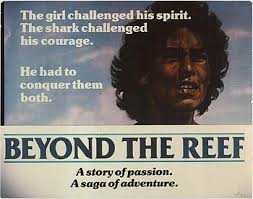
BEYOND THE REEF (SEA KILLER)
US, 1981, 91 minutes, Colour.
Dayton Ka’ne, Maren Jensen.
Directed by Frank C. Clarke.
It follows in the seventies' tradition of Jaws and other films about sharks and fish. However, in this film the shark is benign and a friend of the hero and only menaces bad people! It is based on a novel Ti-koyo and his Shark by Clement Richer. It had previously been filmed under the title of Ti-koyo and the Shark, a French-Italian? co-production in 1962 by Falco Quilici.
The present film is a De Laurentiis production. It was filmed in the same location as his Hurricane and uses the same star Dayton Ka’ne. The film is a pleasant romance, a colourful presentation of the Samoan way of life, a comment on the intrusions of big business and Americanisation. However, it works at a very light pleasing level rather than great substance.
1. An entertaining romantic adventure? Soutli Sea Islands modern story? A film about sharks, their threats, the bond between the boy and the man and his shark?
2. The South Sea Island conventions, the islands and their way of life, beauty, weather? Diving. and fishing? The shark and his attack, friendship? The more primitive way of life and the intrusion of business? The climaxes? The romance? Conventional material ? more?
3. The assets of the location colour photography? Underwater photography? The natural sets? The special effects especially for the diving, the shark? Weather sequences? The South Sea Island style score?
4. The basic plot? Ti-koyo as a boy and his friendship with Diane? The bonds between the two and Diane’s going to America to study and her later return? The friendship with the shark? The advice of the wise man from Hawaii and on his death his spirit entering the shark? The bond between man and shark? The black pearls? The primitive and isolated way of life of Ti-koyo, the resumption of his romance with Diane? The clash with Diane's brother, the Japanese businessmen? happy ending? Conventional material? Realism, fantasy?
5. Ti-koyo as a boy, the destructiveness of sharks,the death of the mother shark, the saving of the baby? His bringing it up and training it? Friendship and companionship? lyrical scenes? The advice of the old Hawaiian, the chart for the black pearls and the right time to dive for them? The friendship with Diane and their playing together? Ti-koyo's growing up, the shark's growing and their constant companionship? protection? The death of the old man and his story about his spirit going into the shark? The film's presentation of this protection by the spirit? the attack on the sophisticated party etc.? The friendship with Diane? The love affair and its consummation? Ti-koyo and the encroachment of progress? The options for Diane and her staying with him? Their future together in the islands? An attractive Samoan hero?
6. The portrait of Diane, her family and background, wealth? Control of industry? tier playing with Ti-koyo as a girl? Her studying in America, her changing to the American way of life, her return? Her girl friend? Parties, sophistication? The memories of Ti-koyo, her going with him, the love affair? Her reaction to the shark? The decisions, dangers? Her final decision?
7. Her girl friend and the giggly romantic attitudes, the Samoan sailor who didn't understand her? A satiric touch?
8. Diane's brother and his power backing, plans for the hotel, the dead body and taking it out to sea and concealing it, its being washed up, fear of shark scares? The Japanese and their plans for building? The divers for the pearls and the attack of the shark?
9. The presence of the shark, character, in the spirit within him, his attacks, the buildings, the people?
10. The happy ending after the clash between primitive and peaceful civilisation and American and commercial civilisation?
11. The basic point of the film - as the story of Ti-koyo and the shark, a romance, a Samoan story?
Published in Movie Reviews
Published in
Movie Reviews
Tagged under